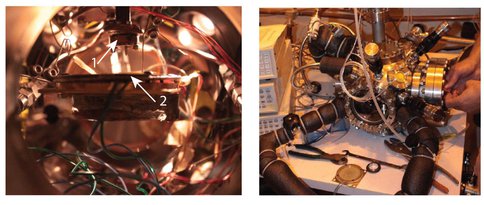2011 Annual Science Report
 NASA Jet Propulsion Laboratory - Titan
Reporting | SEP 2010 – AUG 2011
NASA Jet Propulsion Laboratory - Titan
Reporting | SEP 2010 – AUG 2011
Task 1.2 Interaction of Methane/ethane With Water Ice
Project Summary
Laboratory work led to several results. Tholins are entrained in the subsurface during a methane rain. As the liquid evaporates, the tholins remain trapped in the subsurface. The JPL Titan chamber (Figure 1) also was used to test a rain drop sensor developed by a group of students at University of Idaho that could be embarked on future missions to Titan.
Project Progress
Co-Investigator Christophe Sotin in conjunction with Postdoctoral Fellow Mathieu Choukroun, Undergraduate H. Tom, Collaborator G. Tobie, and Technician R. Mielke modeled the reaction between hydrocarbons and water ice. Recent laboratory experiments explore the consequences of the substitution of methane by ethane when considering liquid ethane percolation through methane-clathrate. The volume change during this reaction is negligible and does not affect the porosity of the subsurface. On the other hand, the mass (and density) increases. Since gravity observations by the Cassini spacecraft suggest that Titan is in hydrostatic equilibrium, the mass increase must be accompanied by subsidence (Pratt model). This reaction is predicted to occur at the poles where ethane rains are predicted by Global Circulation Models (GCMs). It may explain Titan’s shape which is characterized by a flattening higher than that predicted by its spin rate. A paper is in press (Choukroun and Sotin, GRL, 2011).
Additional work involved analyzing the images taken by the radar and the VIMS (Visual and Infrared Mapping Spectrometer) instruments onboard the Cassini spacecraft. The VIMS instrument imaged Ligeia Mare in June 2010 and the shorelines are in close agreement with those identified by the radar instrument. This study suggests that hydrocarbons remain in contact with the icy substrate for long periods of time. As described above, the hydrocarbons should react with an icy crust and/or a methane-clathrate crust until clathration is complete. A paper has been submitted to Icarus.
Finally, they have improved their model of the Schumann resonance in Titan’s cavity formed by its ionosphere and a subsurface conductive layer that is interpreted as a deep ammoniac-rich ocean. The major improvement was to take into account the variations of atmospheric conductivity with altitude. This improved model suggests that the ocean is 70 km (±10 km) deep.
Figure 1: The Titan chamber (right panel) has been used to test a rain drop sensor (right panel) in Titan’s conditions. A pot (arrow 1) of liquid hydrocarbon (methane or ethane) provides drops that fall on the sensor (arrow 2) that is maintained at cold temperature by sitting on a cold plate. The experiment demonstrated that the sensor works at Titan’s cold temperatures.
-
PROJECT INVESTIGATORS:
-
PROJECT MEMBERS:
Gabriel Tobie
Collaborator
Mathieu Choukroun
Postdoc
Randall Mielke
Research Staff
-
RELATED OBJECTIVES:
Objective 1.1
Formation and evolution of habitable planets.
Objective 2.2
Outer Solar System exploration
Objective 3.1
Sources of prebiotic materials and catalysts

